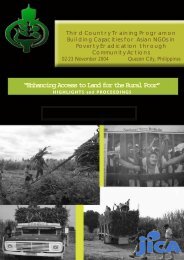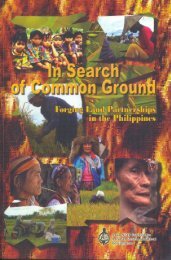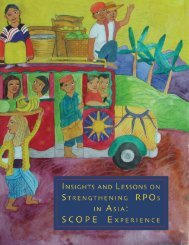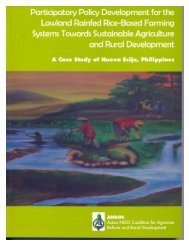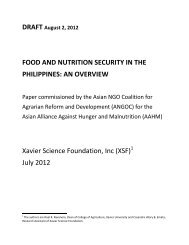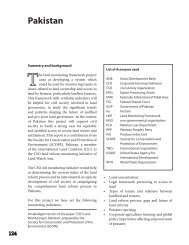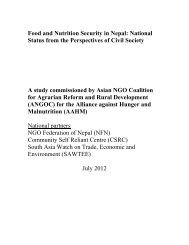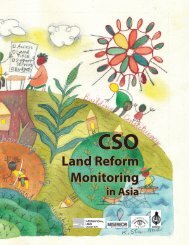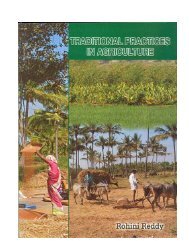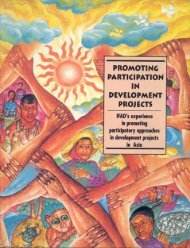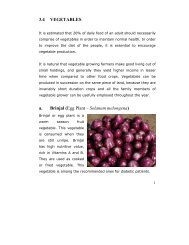Securing the Right to Land FULL - ANGOC
Securing the Right to Land FULL - ANGOC
Securing the Right to Land FULL - ANGOC
Create successful ePaper yourself
Turn your PDF publications into a flip-book with our unique Google optimized e-Paper software.
In 1988, less than 2% of landholders had farms exceeding 24<br />
hectares, but <strong>the</strong>y controlled 36% of all farmland (Quizon, 2007).<br />
According <strong>to</strong> data from <strong>the</strong> National Commission on Indigenous<br />
Peoples (NCIP), <strong>the</strong>re are more than 110 ethnolinguistic groups in<br />
<strong>the</strong> Philippines with an estimated ethnic population of 12 million,<br />
comprising almost 16% of <strong>the</strong> country’s <strong>to</strong>tal population as of<br />
2002. They are among <strong>the</strong> poorest and most disadvantaged social<br />
groups in <strong>the</strong> country. Illiteracy, unemployment and incidence of<br />
poverty are much higher among <strong>the</strong>m than <strong>the</strong> rest of <strong>the</strong> population.<br />
Indigenous Peoples’ (IP) settlements are remote, without<br />
access <strong>to</strong> basic services, and are characterized by a high incidence<br />
of morbidity, mortality and malnutrition. 2<br />
About 80% of <strong>the</strong> municipal fishing families in <strong>the</strong> country are<br />
estimated <strong>to</strong> live below <strong>the</strong> poverty line. These families are entirely<br />
dependent on <strong>the</strong> coastal ecosystem for <strong>the</strong>ir livelihoods<br />
(PARRC, 2008).<br />
<strong>Land</strong> Access for Peace and Development<br />
Poverty, inequitable access <strong>to</strong> land and insurgency have <strong>the</strong>ir<br />
roots intertwined with <strong>the</strong> encomienda system (Adriano, 1991).<br />
Peasant revolts <strong>to</strong> unjust tenurial relations persisted from <strong>the</strong><br />
colonial period until <strong>to</strong>day. The Philippine government unsuccessfully<br />
tried <strong>to</strong> address this insurgency through agrarian reform<br />
laws, which were insufficient.<br />
The highly inequitable distribution of land has caused social<br />
tension and political unrest and inhibited <strong>the</strong> country’s economic<br />
growth (Balisacan, et al.,2002). Meanwhile, <strong>the</strong> experiences<br />
of Japan, Korea and Taiwan confirm that land reform is<br />
<strong>the</strong> foundation for mobilizing agrarian societies <strong>to</strong>wards rural,<br />
and ultimately urban industrialization (Delos Reyes & Jopillo,<br />
1994 citing Korten, 1990). <strong>Land</strong> reform promotes higher agricultural<br />
productivity and creates purchasing power in rural areas,<br />
thus creating capital and markets for industry. Recent<br />
studies in <strong>the</strong> Philippines show that when agrarian reform is<br />
implemented properly and integrated support services are provided,<br />
farmers have higher incomes, invest in <strong>the</strong>ir farms more<br />
intensively, and have a more positive outlook (DAR, 2007).<br />
Legal Framework of Access <strong>to</strong> <strong>Land</strong> and<br />
Tenurial Security in <strong>the</strong> Philippines 3<br />
Roots of <strong>Land</strong> Ownership Regulation in <strong>the</strong> Philippines 4<br />
Private land ownership was first introduced under <strong>the</strong> Regalian<br />
doctrine during <strong>the</strong> Spanish colonial period. This became <strong>the</strong> ba-<br />
DEFENDING THE GAINS OF TENURIAL REFORM<br />
133<br />
sis for all land laws in <strong>the</strong> country under <strong>the</strong> 1935, 1973 and <strong>the</strong><br />
1987 Constitutions. The Regalian doctrine provides that all lands<br />
of <strong>the</strong> public domain and o<strong>the</strong>r natural resources belong <strong>to</strong> <strong>the</strong><br />
King of Spain. When <strong>the</strong> republican system was introduced, <strong>the</strong><br />
State became <strong>the</strong> rightful heir <strong>to</strong> <strong>the</strong> King.<br />
Traditional systems of communal ownership were broken up<br />
and not accorded legal recognition, disenfranchising native Filipinos.<br />
American occupation later upheld <strong>the</strong> Spanish system of<br />
cadastral laws and introduced <strong>the</strong> Torrens Title system under<br />
<strong>the</strong> 1902 <strong>Land</strong> Registration Act.<br />
Earlier policy efforts <strong>to</strong> broaden access <strong>to</strong> public land consisted<br />
mainly of opening up new areas for application of land patents,<br />
reforms in land titling and administration systems, and<br />
<strong>the</strong> introduction of systems for recognizing occupancy rights.<br />
In terms of private agriculture lands, land reform policy was<br />
introduced as early as 1963 through <strong>the</strong> Agricultural Tenancy<br />
Act, which sought <strong>to</strong> improve tenancy systems in agriculture.<br />
Presidential Decree (P.D.) 27 promulgated in 1972 provided for<br />
<strong>the</strong> compulsory acquisition and redistribution of all rice and<br />
corn lands. The measure allowed for: (i) <strong>the</strong> compulsory acquisition<br />
of private lands; (ii) lowering of land ownership ceiling from<br />
75 <strong>to</strong> 7 hectares; and (iii) provision of support services <strong>to</strong> beneficiaries.<br />
Many saw this as a move <strong>to</strong> quell agrarian unrest in<br />
heavily tenanted areas, ra<strong>the</strong>r than <strong>to</strong> institute broader access<br />
<strong>to</strong> land. Large plantations remained un<strong>to</strong>uched and corporate<br />
farming for up <strong>to</strong> 500 hectares was even encouraged in rice.<br />
Poor communities were displaced as lands were taken over by<br />
government corporations, large-scale development projects and<br />
logging and mining concessions. The introduction of Timber License<br />
Agreements (TLAs) allowed privileged individuals <strong>to</strong> extract<br />
forest resources.<br />
When negative impacts of forest destruction emerged, <strong>the</strong> government<br />
tried new policies and programs that involved communities<br />
in forest management (e.g., Forest Occupancy Management<br />
[FOM] in 1975 and <strong>the</strong> Family Approach <strong>to</strong> Reforestation [FAR] in<br />
1976). However, <strong>the</strong>se programs caused upland communities,<br />
including <strong>the</strong> IPs, <strong>to</strong> be treated as squatters (informal settlers) in<br />
<strong>the</strong>ir own ancestral lands and became a source of cheap labor for<br />
<strong>the</strong> aforementioned programs (Pulhin and Dizon, 2003). Meanwhile,<br />
squatting was made a criminal act by P.D. 772.<br />
ASIAN NGO COALITION FOR AGRARIAN REFORM AND RURAL DEVELOPMENT



